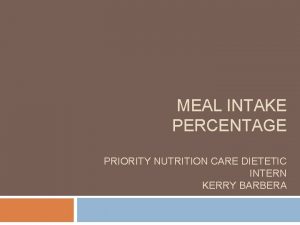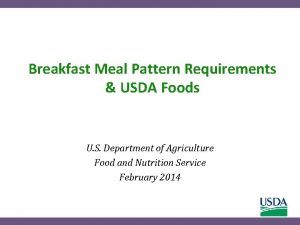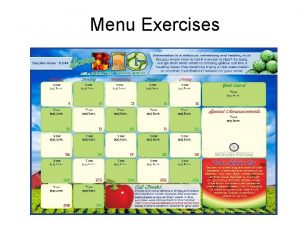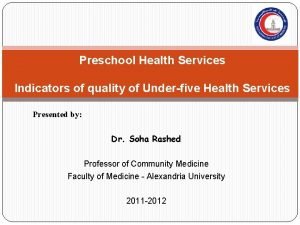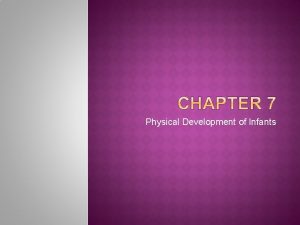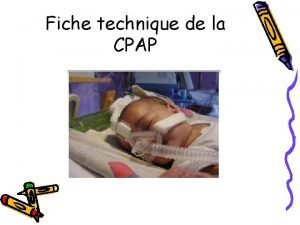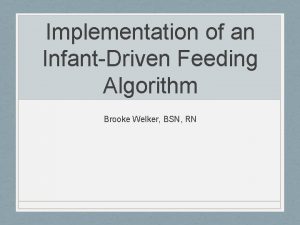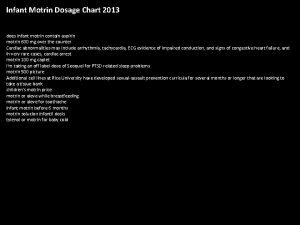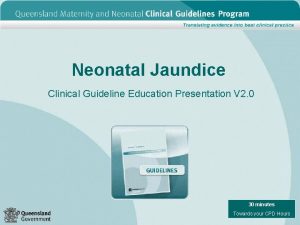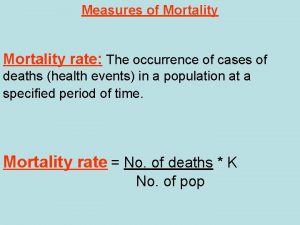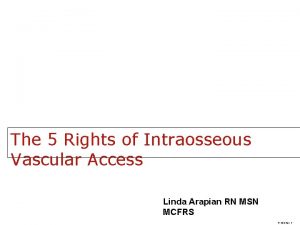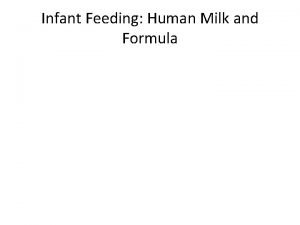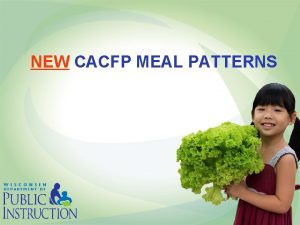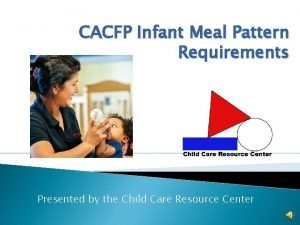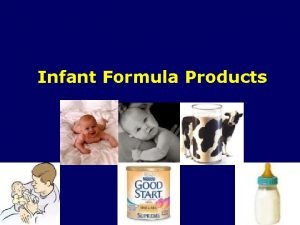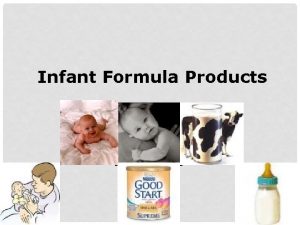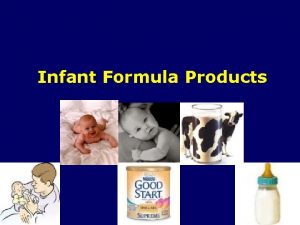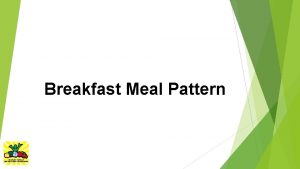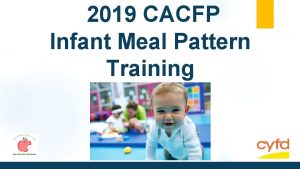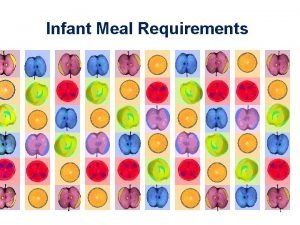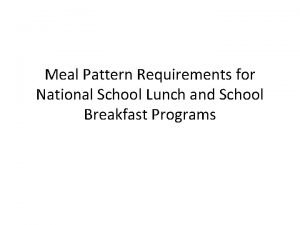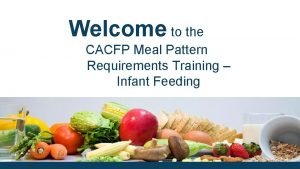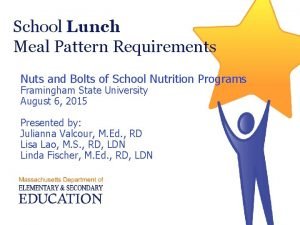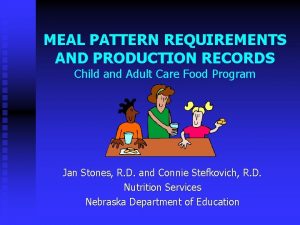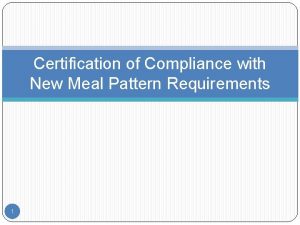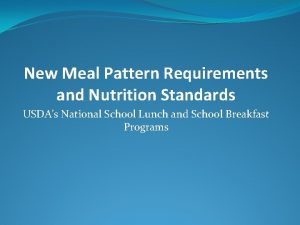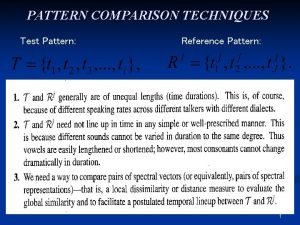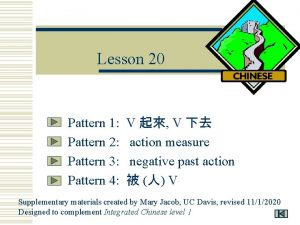Infant Meal Pattern Requirements Infant Meal Pattern Requirements
















































- Slides: 48

Infant Meal Pattern Requirements

Infant Meal Pattern Requirements Overview • Meals support mothers who breastfeed • Features two age groups: Birth-5 months & 6 -11 months • Provides more nutritious meals and snacks o Vegetables & fruits must be served at snack o Juice, cheese food, or cheese spread are no longer creditable o Yogurt & whole eggs are allowable meat alternates

Lesson Objectives • Summarize at least two advantages for the age groups • Identify at least two ways that the updated meal patterns support breastfeeding • State three strategies for supporting developmental readiness • Explain at least four new requirements for serving solid foods

Infant Meal Pattern Age Groups Birth – 5 months 6 -11 months

What are some advantages of having two age groups?

Encourages Breastfeeding • Breastmilk is the optimal source of nutrients • Birth through the end of 5 months o Breastmilk or infant formula is the only meal component required o Minimum serving size is 4 -6 oz of breastmilk (or infant formula)

Promotes Developmental Readiness • Delay the introduction of solid foods until around 6 months • Most infants are not ready to consume solid foods until midway through the 1 st year • Introducing solid foods too soon increases risk of obesity

Allows More Nutritious Foods • Foods from all food components may be served around 6 months, when developmentally ready • Breakfast, Lunch, & Supper o Breastmilk or iron-fortified infant formula o Infant cereal, meat/meat alternates, or a combination of both o Vegetable or fruit, or a combination of both • Snack o Breastmilk or iron-fortified infant formula o Grains o Vegetable or fruit, or a combination of both

Focuses on Serving Sizes • Food components beginning with “zero” o Recognizes that all infants are not ready for solid foods at 6 months • By 7 or 8 months, infants should be consuming solid foods from all food groups Serving Sizes 0 -2 oz. 0 -4 tbsp.

Focuses on Eating Habits • Recognizes eating habits may change o Some infants may eat certain foods one week/day, but not the next o Meals & snacks consistent with eating habits should not be disallowed

Breastmilk & Infants • Promote breastfeeding by encouraging: o a parent/guardian to supply expressed breastmilk o a mother to breastfeed her infant on-site

Serving Expressed Milk • Breastfed infants may not consume the entire serving o Offer less than the minimum serving size of breastmilk o Offer additional breastmilk later, if infant will consume more • Feed on demand

Iron-Fortified Infant Formula • Best supplement for breastmilk • Supports healthy brain development & growth • An infant may be fed: o Iron-fortified formula o Breastmilk o Combination of both

Supplying Formula • Offer a minimum of 1 type of iron- fortified infant formula if on CACFP • Formula must be regulated by FDA o May not credit if purchased outside U. S. o Doctor’s note needed if formula served has no iron.

Serving Formula • Infants may not drink the entire serving of formula o Reimbursable as long as the minimum serving size is offered • Any leftovers should be properly stored in accordance with local health and safety requirements • Feed on demand

Disabilities & Substitutions • Modifications must be made for infants with disabilities who need accommodations • A medical statement must be on file to receive CACFP reimbursement o Explain the need for the modification o Provide guidance for the substitution or meal modification

Developmental Readiness • Introducing solid foods too early: o cause choking o consume less breastmilk or formula • Serve solid foods when infants are developmentally ready

American Academy of Pediatrics Developmental Readiness Guidelines • Sits in chair with good head control • Opens mouth for food • Moves food from a spoon into throat • Doubles in birth weight

Parent Communication • Working with parents helps to o Ensure newly introduced foods are most ideal o Be consistent with eating habits o Support developmental readiness • Always consult with parents/guardians first before serving solid foods

Optional Written Statement • Request a written statement from parents or guardians: o outlining when & which solid foods to serve • Follows the preferences of parents & guardians

Providing Food Components • Parents/guardians may provide only one creditable food component for a CACFP reimbursable meal o i. e. , provide breastmilk = 1 component • Child care providers must provide remaining components

Introducing Solid Food(s) • Once an infant shows signs of developmental readiness, solid foods must be offered • Gradually introduce solid foods o One at a time o Over the course of a few days

Introducing Solid Food(s) (cont. ) • Prepare foods in the right texture and consistency • Observe infants closely for reactions after feeding a new food

Vegetables & Fruits • Great source of essential nutrients o i. e. , fiber & vitamin C • Minimum serving size: 0 -2 tbsp. • Required at all meals & snacks o Serve vegetable, fruit, or a combination of both o Increases consumption & allows for better acceptance later in life

Juice • Lacks dietary fiber found in other forms of fruits & vegetables • No longer allowed to be served to infants X

Meat/Meat Alternates • Poultry & other meats • Yogurt • Cheese • Whole Eggs • Dry beans

Yogurt • Great source of protein • Minimum serving size: 0 -4 oz • Maybe served during breakfast, lunch, or supper

Yogurt & Added Sugar • Some have higher sugar content than others • Must contain no more than 23 grams of total sugars per 6 oz o Applies to all age groups

Nutrition Facts Label • Helpful for identifying nutritious foods o i. e. , Yogurt • Found on packaged foods • New Label required by July 2018

Key Terms • Serving Size o Number of servings in a package o Unit: ounces, cups, per container, etc. • Sugars or Total Sugars o Amount per serving o Means the same thing

Yogurt Sugar Limits Serving Size (Ounces) Serving Size (Grams) Sugar Limits 64 grams 0 -9 grams 3. 5 ounces 99 grams 0 -13 grams 4 ounces 113 grams 0 -15 grams 5. 3 ounces 150 grams 0 -20 grams 6 ounces 170 grams 0 -23 grams 8 ounces 227 grams 0 -31 grams Yogurt: Method 2. 25 ounces #1 Chart

Example #1: Serving Size in Ounces • Step 1: Find the Nutrition Facts Label on the package • Step 2: Identify the serving size: 6 oz • Step 3: Find the amount for Sugars: 19 grams

Example #1: Serving Size in Ounces (cont. ) Step 4: Find the Serving Size in the chart • Serving size: 6 oz • Total sugars: 19 grams Yogurt Sugar Limits Serving Size (Ounces) (Grams) Sugar Limits 2. 25 ounces 64 grams 0 -9 grams 3. 5 ounces 99 grams 0 -13 grams 4 ounces 113 grams 0 -15 grams 5. 3 ounces 150 grams 0 -20 grams 6 ounces 170 grams 0 -23 grams 8 ounces 227 grams 0 -31 grams

Is it Creditable?

Yes, it is creditable – 19 grams is between 0 -23 sugar limit!

Example #2: Serving Size in Grams Yogurt Sugar Limits Serving Size (Ounces) Serving Size Sugar Limits (Grams) 2. 25 ounces 64 grams 0 -9 grams Serving size: 1 container (170 g) 3. 5 ounces 99 grams 0 -13 grams 4 ounces 113 grams 0 -15 grams Sugars: 19 grams 5. 3 ounces 150 grams 0 -20 grams 6 ounces 170 grams 0 -23 grams 8 ounces 227 grams 0 -31 grams

Yogurt: Method #2 Calculation • Designed for serving sizes not listed on the chart • Calculate the total amount of sugar per ounce or gram to determine if the yogurt item is within the threshold o Serving Size in Ounces Threshold § 23 ÷ 6 = 3. 83 o Serving Size in Grams Threshold § 23 ÷ 170 = 0. 135

Example #1: Serving Size in Ounces Step 1: Find the Nutrition Facts Label Step 2: Identify the Serving Size: 4. 5 oz Step 3: Find the amount for Sugars: 16 g

Example #1: Serving Size in Ounces (cont. ) •

Example #2: Serving Size in Grams •

Activity: Yogurt–Is it Creditable?

Whole Eggs • AAP found no convincing evidence to delay foods considered major food allergens • Whole eggs are now creditable for infant meals • Minimum serving size: 0 -4 tbsp.

Cheese • Minimum serving size: 0 -2 oz • Cheese & cottage cheese • Common examples o Shredded or sliced Swiss, Colby, & Monterey Jack

Cheese foods & cheese spreads are not allowed for infant meals & snacks…

Non-Allowed Cheese Foods • Product packaging states: o “Imitation cheese” o “Cheese food” o “Cheese product” • Common items o Cheese whips o Cheese with pimento o Cream cheese

Grains & Infant Cereals • Iron-fortified infant cereals are often the first solid foods: o Often easiest to digest o Least likely to cause an allergic reaction • Serve at meals & snacks when infants are developmentally ready • Minimum serving size: 0 -4 tbsp.

Snack Meals Only • Bread, crackers, & ready-to-eat breakfast cereals • Ready-to-eat breakfast cereals: No more than 6 grams of sugar per dry oz • See Cereal Sugar Chart in Grains Requirement

Do your infant meals meet the requirements? • Plan your menus using the Infant Menu Planner. • Use the CACFP Menu Checklist: Infant Meal Pattern. • Follow the Infant Meal Pattern guide.
 Abbott percentage of intake chart
Abbott percentage of intake chart Breakfast meal pattern
Breakfast meal pattern Meal pattern example
Meal pattern example Lunch meal pattern
Lunch meal pattern What is habituation
What is habituation Infant age
Infant age Wood street infant school
Wood street infant school Woodfield infant school
Woodfield infant school Pulse check in unresponsive victim
Pulse check in unresponsive victim Neonatal mortality rate
Neonatal mortality rate An infant's growth refers to changes in
An infant's growth refers to changes in Infant flow driver
Infant flow driver Transport incubator
Transport incubator Infant oral health care
Infant oral health care Infant skull
Infant skull Downs view infant school
Downs view infant school Embrace infant warmer
Embrace infant warmer Brigance test for 2 year-old
Brigance test for 2 year-old Infant driven feeding readiness scale
Infant driven feeding readiness scale Infant motrin coupon
Infant motrin coupon Types of jaundice pdf
Types of jaundice pdf Catherine maguire infant mental health
Catherine maguire infant mental health Promoting infant health section 7-2
Promoting infant health section 7-2 Infant-industry argument
Infant-industry argument Juan soriano la niña muerta; the dead girl; dead infant
Juan soriano la niña muerta; the dead girl; dead infant Pat ticls
Pat ticls Infant mortality rate formula
Infant mortality rate formula Ilfeld brace
Ilfeld brace Saguaro infant care and preschool
Saguaro infant care and preschool Infant cpr algorithm
Infant cpr algorithm Pregnancy and infant cohort monitoring and evaluation
Pregnancy and infant cohort monitoring and evaluation Infant industries apush
Infant industries apush Infant botulism
Infant botulism Newborn reflexes definition
Newborn reflexes definition Kenmore park infant and nursery school
Kenmore park infant and nursery school For sale: baby shoes, never worn.
For sale: baby shoes, never worn. Social impulses foster infant language
Social impulses foster infant language Phoenix infant academy
Phoenix infant academy Infant mortality rate formula
Infant mortality rate formula Femoral pulse in child
Femoral pulse in child Cbr definition ap human geography
Cbr definition ap human geography Counter clockwise
Counter clockwise Hip dysplasia alpha angle
Hip dysplasia alpha angle Infants display a wide range of emotional expressions
Infants display a wide range of emotional expressions Infant mortality rate formula
Infant mortality rate formula Infant death rate
Infant death rate Infant reflexes chart
Infant reflexes chart Infant industry
Infant industry Gos infant formula
Gos infant formula
